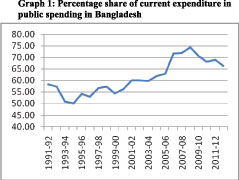
FY15 budget: Promoting inclusive growth
Abul Basher | Sunday, 4 May 2014

The budget for financial year 2014-15 (FY15) is in the offing. The development initiatives of the government in Bangladesh are mainly guided by a five-year plan, formulated in every five years on the basis of the review of the problems and prospect of the economy. The political vision of the government also plays a role in identifying different imperatives in the development plan. The budget, announced in every June, is a yearly instrument to achieve the broad development objectives set out in the five-year plan.
One of the main objectives of the current five-year plan is to promote inclusive growth - economic growth with its benefits being evenly distributed among different socio-economic groups of the country. In other words, it means everybody has to be involved in the process of growth. While the private sector will evolve on its own momentum following the hunger for profit, it is the mainly the job of the government to implement an expenditure scheme that will promote the participation of all citizens in the process of development. How good or a bad is a budget in Bangladesh, depends on the alignment of the expenditure scheme chalked out in it with inclusive growth.
The ongoing five-year plan was formulated by the current government during its last tenure. Therefore, it can be assumed the vision envisaged in this plan is still owned by the government. Hence, it can be expected that FY15 budget, by all means, will try to contribute to the inclusive growth in the country. Complementing the initiatives undertaken in the budget, the government is also expected to take other measures to promote inclusive growth in the country.
Historically, the government of Bangladesh uses different channels of public spending as well as other measures to promote financial inclusion to enhance growth and inclusiveness. While spending on infrastructure and social sector can promote long-term growth and inclusiveness, the same on social protection and subsidies can benefit those who would otherwise be excluded from the gain from growth in the short and immediate terms. However, the efficacy of these measures in promoting inclusiveness crucially depends on whether the government finances productive economic activities and directly assists the people belonging to bottom echelons of income distribution or it mainly finances its current expenditure.
Generally speaking, resource available to the government after meeting the non-discretionary expenses which are known as current expenditures, determines its ability to undertake any activities to expedite inclusive growth. Tax policy can play a dual role to promote inclusive growth. It can create a distortion favouring the growth of sectors that provides job opportunities for the poor. At the same time, collection of more revenue can enable the government to undertake more activities that favours inclusive growth.
A review of total public expenditures in Bangladesh over the last two decades indicates that current expenditure accounts for more than 50 per cent of total expenditure shows an increasing trend, albeit decreasing in last five consecutive years. In FY13, total current expenditure accounted for about 10 per cent of GDP (gross development product), while annual development programme (ADP) expenditure accounted only half of it. Because of this stringent fiscal inflexibility of the government, public spending on health and education as percentage of GDP has barely increased in the recent years.
Existing analyses of welfare implication of subsidies show that most of them are highly regressive. Their benefits are disproportionately in favour of the rich. Although total subsidies account for about 3.0 per cent of GDP, they do not contribute much to inclusive growth.
Different social safety net programmes accounted for about 2.4 per cent of GDP in FY13. Proportion of households with access to these programmes has increased from 12 per cent in 2005 to 24 per cent in 2010. According to the World Bank (2013), the relative performance of these programmes deteriorated in terms of leakage (proportion of non-poor recipient households), targeting efficiency (share of total programme spending accruing to the poor), and generosity (share of total consumption accounted for by the transfer). The Bangladesh Institute of Development Studies (2013) found the social safety net programmes in general better targeted but plagued by leakages. It is important allocation to these programmes be increased in the coming budget. Equally important is to increase their efficacy.
Along with the fiscal stance of the government, financial inclusion is also a significant determinant of inclusive growth. According to the latest information available, about one-fourth of total population lack access to any financial services, and slightly less than half of the total population lack access to any credit market. Poor Banking infrastructure, lack of financial literacy, high cost and lack of suitable financial products have been identified as main roadblocks to financial inclusion.
To enhance inclusiveness, the government may think of the following actions in the upcoming budget: (i) reduce the dominance of current spending in total spending, (ii) increase spending on infrastructure with high employment intensity and social sectors, (iii) reduce the dependence on generalised subsidies accompanied with introduction of cash transfer or vouchers for poor, (iv) prevent the leakages from the social safety net programmes and reduce their implementation cost, and (v) increase financial inclusion.
Dr Abul Basher is Researcher at Bangladesh Institute of Development Studies (BIDS), former economist, World Bank, and former faculty, Willamette University, USA.
cccg67@yahoo.com